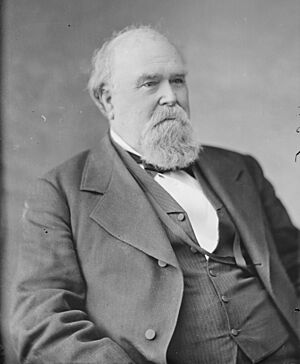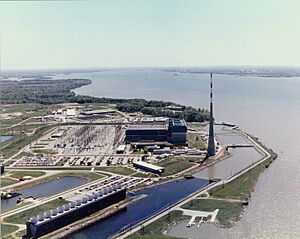Athens, Alabama facts for kids
Quick facts for kids
Athens, Alabama
|
|||
|---|---|---|---|
|
City
|
|||
| City of Athens | |||
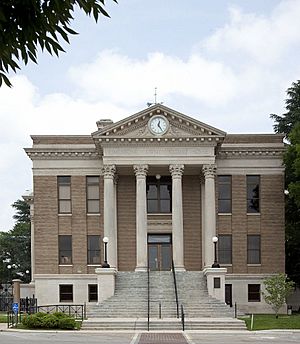
Limestone County Courthouse in Athens
|
|||
|
|||
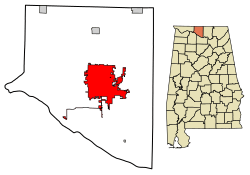
Location of Athens in Limestone County, Alabama
|
|||
| Country | |||
| State | |||
| County | Limestone | ||
| Incorporated | November 19, 1818 | ||
| Named for | Athens, Greece | ||
| Government | |||
| • Type | Mayor Council | ||
| Area | |||
| • Total | 40.87 sq mi (105.85 km2) | ||
| • Land | 40.60 sq mi (105.16 km2) | ||
| • Water | 0.26 sq mi (0.68 km2) | ||
| Elevation | 663 ft (202 m) | ||
| Population
(2020)
|
|||
| • Total | 25,406 | ||
| • Estimate
(2023)
|
30,904 | ||
| • Density | 625.70/sq mi (241.58/km2) | ||
| Time zone | UTC−6 (CST) | ||
| • Summer (DST) | UTC−5 (CDT) | ||
| ZIP Code |
35611–35614–35613
|
||
| Area codes | 256 | ||
| FIPS code | 01-02956 | ||
| GNIS feature ID | 2403123 | ||
Athens is a city located in Limestone County, Alabama, in the United States. It is the main city, or county seat, of Limestone County. Athens is part of a larger area called the Huntsville-Decatur-Albertville, AL Combined Statistical Area. In 2020, about 25,406 people lived in Athens.
Contents
Discovering Athens' Past
Athens was started in 1818 by four people: John Coffee, Robert Beaty, John D. Carroll, and John Read. It is one of the oldest cities in Alabama. The city was officially made a city (incorporated) one year before Alabama became a state in 1819. Limestone County was also created in 1818. The town was first called Athenson, but its name was changed to Athens, like the ancient city in Greece. Samuel Tanner was the first mayor of Athens. The Tanner area, which is south of Athens, was named after him.
The Athens area was home to two early governors of Alabama. William Wyatt Bibb was the first governor. His brother, Thomas Bibb, became the second governor after William passed away.
Athens State University's Story
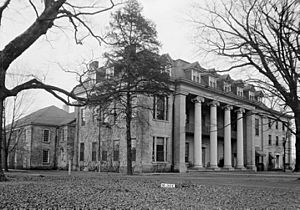
In 1822, people in Athens bought land to build the Athens Female Academy. This school later joined with the Methodist church in 1842 and was renamed Athens Female College. In 1932, boys were allowed to attend, and the school became Athens College. The State of Alabama took over the college in 1974. It then became a special kind of college that offered the last two years of study for students who had finished community college. Today, it is known as Athens State University.
Many old homes in the center of Athens were built before the Civil War. These homes are now protected as part of historic areas.
Athens During the Civil War
During the Civil War, Union soldiers took control of Athens on May 2, 1862. Their leader, Col. John Basil Turchin, reportedly told his men he would "shut his eyes for two hours." While he was away, his soldiers searched the town.
Athens was also the home of Governor George S. Houston. He was Alabama's first Democratic governor after the Reconstruction period, serving from 1874 to 1878. He worked to reduce the state's debts. During Reconstruction, the Trinity School was founded in Athens for the children of former slaves. Mary Fletcher Wells started the school, and the American Missionary Association helped fund it.
Athens' Changing Economy
Athens used to be known for its cotton farms and railroads. However, since the 1950s and 1960s, the area has seen a growth in aerospace industries. This has made Athens more connected to the nearby industrial city of Huntsville, as cotton farming has become less common.
Athens is home to the Browns Ferry Nuclear Power Plant. This plant, run by the Tennessee Valley Authority, started operating in 1974. It was once the largest nuclear plant in the world. It provides many jobs and most of the electricity for the Huntsville-Decatur Metro Area. In 1975, a fire at the plant caused a serious event, though no one was hurt. A worker checking for air leaks accidentally started a fire among control wires. This briefly threatened the control of the reactor.
Where is Athens Located?
Athens is located right between Nashville and Birmingham on Interstate 65. It also shares a border with the city of Huntsville.
The U.S. Census Bureau says that Athens covers about 39.4 square miles (102 square kilometers). Most of this area is land, with a small part being water.
Athens' Weather and Climate
The weather in Athens has hot, humid summers and generally cool winters. According to the Köppen climate classification system, Athens has a humid subtropical climate. This means it has warm temperatures and plenty of rain throughout the year.
| Climate data for Athens, Alabama (1991–2020, extremes 1991–present) | |||||||||||||
|---|---|---|---|---|---|---|---|---|---|---|---|---|---|
| Month | Jan | Feb | Mar | Apr | May | Jun | Jul | Aug | Sep | Oct | Nov | Dec | Year |
| Record high °F (°C) | 78 (26) |
84 (29) |
87 (31) |
91 (33) |
94 (34) |
104 (40) |
102 (39) |
104 (40) |
100 (38) |
102 (39) |
87 (31) |
78 (26) |
104 (40) |
| Mean maximum °F (°C) | 68.9 (20.5) |
73.5 (23.1) |
81.2 (27.3) |
85.7 (29.8) |
90.3 (32.4) |
95.1 (35.1) |
96.0 (35.6) |
96.7 (35.9) |
93.8 (34.3) |
88.6 (31.4) |
77.2 (25.1) |
72.3 (22.4) |
98.8 (37.1) |
| Mean daily maximum °F (°C) | 51.3 (10.7) |
55.9 (13.3) |
64.5 (18.1) |
73.3 (22.9) |
80.4 (26.9) |
87.1 (30.6) |
89.9 (32.2) |
89.8 (32.1) |
84.9 (29.4) |
74.7 (23.7) |
63.0 (17.2) |
54.2 (12.3) |
72.4 (22.4) |
| Daily mean °F (°C) | 42.4 (5.8) |
46.3 (7.9) |
54.0 (12.2) |
62.3 (16.8) |
70.4 (21.3) |
77.8 (25.4) |
81.0 (27.2) |
80.3 (26.8) |
74.7 (23.7) |
63.7 (17.6) |
52.4 (11.3) |
45.4 (7.4) |
62.6 (17.0) |
| Mean daily minimum °F (°C) | 33.5 (0.8) |
36.7 (2.6) |
43.5 (6.4) |
51.3 (10.7) |
60.4 (15.8) |
68.4 (20.2) |
72.1 (22.3) |
70.9 (21.6) |
64.5 (18.1) |
52.6 (11.4) |
41.9 (5.5) |
36.5 (2.5) |
52.7 (11.5) |
| Mean minimum °F (°C) | 14.5 (−9.7) |
18.9 (−7.3) |
25.9 (−3.4) |
34.5 (1.4) |
44.4 (6.9) |
57.7 (14.3) |
62.7 (17.1) |
62.3 (16.8) |
50.9 (10.5) |
35.7 (2.1) |
24.9 (−3.9) |
21.7 (−5.7) |
12.9 (−10.6) |
| Record low °F (°C) | 0 (−18) |
−1 (−18) |
12 (−11) |
23 (−5) |
37 (3) |
47 (8) |
57 (14) |
50 (10) |
39 (4) |
28 (−2) |
16 (−9) |
3 (−16) |
−1 (−18) |
| Average precipitation inches (mm) | 5.52 (140) |
5.43 (138) |
5.59 (142) |
5.40 (137) |
4.85 (123) |
4.76 (121) |
4.89 (124) |
3.93 (100) |
3.77 (96) |
4.02 (102) |
4.61 (117) |
6.29 (160) |
59.06 (1,500) |
| Average snowfall inches (cm) | 0.5 (1.3) |
0.5 (1.3) |
0.3 (0.76) |
0.0 (0.0) |
0.0 (0.0) |
0.0 (0.0) |
0.0 (0.0) |
0.0 (0.0) |
0.0 (0.0) |
0.0 (0.0) |
0.0 (0.0) |
0.0 (0.0) |
1.3 (3.3) |
| Average precipitation days (≥ 0.01 in) | 10.9 | 11.7 | 11.7 | 10.1 | 11.0 | 11.4 | 11.3 | 9.8 | 8.2 | 9.2 | 10.4 | 12.0 | 127.7 |
| Average snowy days (≥ 0.1 in) | 0.3 | 0.2 | 0.0 | 0.0 | 0.0 | 0.0 | 0.0 | 0.0 | 0.0 | 0.0 | 0.0 | 0.1 | 0.6 |
| Source: NOAA (mean maxima/minima 2006–2020) | |||||||||||||
People Living in Athens
Athens first appeared on the U.S. Census in 1850. It has been listed in every census since 1870. Athens was one of the fastest-growing areas in Alabama in 2023. Estimates showed that 30,904 people lived there.
| Historical population | |||
|---|---|---|---|
| Census | Pop. | %± | |
| 1850 | 991 | — | |
| 1870 | 887 | — | |
| 1880 | 1,011 | 14.0% | |
| 1890 | 940 | −7.0% | |
| 1900 | 1,010 | 7.4% | |
| 1910 | 1,715 | 69.8% | |
| 1920 | 3,323 | 93.8% | |
| 1930 | 4,238 | 27.5% | |
| 1940 | 4,342 | 2.5% | |
| 1950 | 6,309 | 45.3% | |
| 1960 | 9,330 | 47.9% | |
| 1970 | 14,360 | 53.9% | |
| 1980 | 14,558 | 1.4% | |
| 1990 | 16,901 | 16.1% | |
| 2000 | 18,967 | 12.2% | |
| 2010 | 21,897 | 15.4% | |
| 2020 | 25,406 | 16.0% | |
| 2023 (est.) | 30,904 | 41.1% | |
| Sources: 1850; 1870 and 1880; 1900, 1910, and 1920; 1930, 1940, and 1950; 1960, 1970, and 1980; 1990; 2000 and 2010 |
|||
Census Information from 2010
In 2010, there were 21,897 people living in Athens. There were 9,038 households and 5,881 families. The city had about 557 people per square mile (215 people per square kilometer). There were 9,862 housing units.
The population was made up of different groups:
- 73.0% White
- 17.5% Black or African American
- 0.6% Native American
- 0.9% Asian
- 0.1% Pacific Islander
- 5.9% from other races
- 1.9% from two or more races
- 8.8% of the population was Hispanic or Latino of any race.
About 27.7% of households had children under 18. About 47.5% were married couples. The average household had 2.36 people, and the average family had 2.96 people.
The median age in the city was 39.2 years old. About 22.8% of the population was under 18.
The median income for a household in Athens was $42,127. For a family, it was $54,013. About 17.5% of the population lived below the poverty line.
Census Information from 2020
| Race | Num. | Perc. |
|---|---|---|
| White (non-Hispanic) | 17,160 | 67.54% |
| Black or African American (non-Hispanic) | 4,275 | 16.83% |
| Native American | 74 | 0.29% |
| Asian | 240 | 0.94% |
| Pacific Islander | 34 | 0.13% |
| Other/Mixed | 1,208 | 4.75% |
| Hispanic or Latino | 2,415 | 9.51% |
As of the 2020 United States census, there were 25,406 people living in Athens. There were 9,397 households and 6,080 families.
How to Get Around Athens
Athens has several important roads and transportation options:
 I-65
I-65 US 31
US 31 US 72
US 72- Norfolk Southern Railway (trains)
- CSX Transportation railroad (trains)
 Pryor Field Regional Airport (a local airport)
Pryor Field Regional Airport (a local airport)
You can also travel by bus with Greyhound Lines.
Schools in Athens
- Athens City Schools
- Athens State University
Local Media
- The News Courier, a daily newspaper
- WVNN 770 AM (radio station)
- WKAC 1080 AM (radio station)
- WZYP 104.3 FM (radio station)
- WTZT-CD TV channel 11 (TV station)
Famous People from Athens
- Woody Abernathy, a former professional baseball player
- Sheila Andrews, a country music singer
- Bill Arnsparger, a football coach who helped the Miami Dolphins win two Super Bowls
- Keith Askins, an NBA assistant coach and former player for the Miami Heat
- Michael Boley, a former NFL player for the New York Giants
- George Ruffin Bridgeforth, a professor at Tuskegee Institute
- Wally Bullington, a head football coach for Abilene Christian University
- Tom Calvin, a former NFL player
- Dick Coffman, a former Major League Baseball player
- Slick Coffman, a former Major League Baseball player
- Billy Davis, a former member of the Arizona State Senate
- P. O. Davis, an early radio pioneer and agricultural educator
- Anderson East, an R&B singer
- Richard Hendrix, a professional basketball player
- Jake Hess, a Grammy Award-winning southern gospel singer
- Brittany Howard, a singer and guitarist for Alabama Shakes
- C. Eric Lincoln, an African-American scholar
- Patti J. Malone, a famous African-American mezzo-soprano singer
- Bobby Marlow, a former Canadian Football League player
- John Mason Martin, a U.S. Representative
- Mitch McConnell, a U. S. Senator from Kentucky, who lived in Athens as a child
- Alfred McCullough, an American football player
- Kevin Miller, a radio talk show host
- Roger Murrah, a songwriter
- Andy Nelson, a former football player for the Baltimore Colts and New York Giants
- Edmund Pettus, a lawyer, soldier, and U.S. Senator
- Luke Pryor, a U.S. Senator and U.S. Representative
- Wayne Redmond, a former baseball player for the Detroit Tigers
- William N. Richardson, a U.S. Representative
- Philip Rivers, an NFL quarterback for the San Diego Chargers
- Charles Henry Sykes, an editorial cartoonist
- Charles Coleman Thach, a president of Auburn University
- Alice Vassar LaCour, a Fisk Jubilee singer and teacher
- Lee Vickers, a professional football player
- James C. Watkins, a ceramic artist
- Quez Watkins, a professional football player
- Henry A. White, an Alabama educator and state representative
Images for kids
See also
 In Spanish: Athens (Alabama) para niños
In Spanish: Athens (Alabama) para niños







